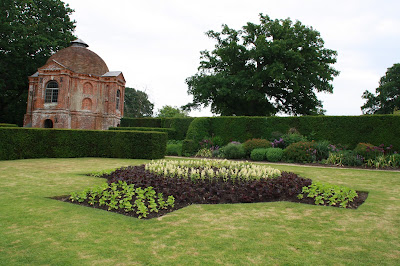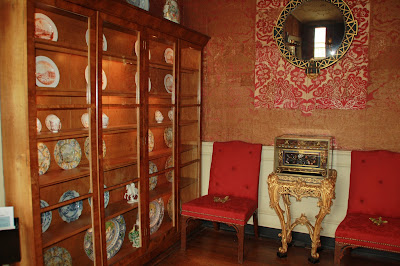May I just reiterate once again how much I love living in Hampshire? One Austenesque event after another happening around me... so much so that I struggle to attend all of them!
Last week there was a talk at my local library, interestingly titled "Mrs Clay's Freckles", given by Annalie Talent - the Learning Officer at Jane Austen's House Museum, Chawton. Persuasion being my favourite Jane Austen novel, I could immediately tell that the talk was about beauty in Jane Austen's time.
In the novel Persuasion, Mrs Clay is companion to Anne Elliott's sister, Elizabeth, who aspires to become Sir Walter Elliott's wife. The incredibly vain Sir Walter approves of Mrs Clay with the exception of her buck teeth and freckles, which he keeps remarking on in her absence.
Did you know that mice fur was used to accentuate the eyebrows in the 18th Century?
And that fresh air and exercise was considered to be the best blusher in the Regency era?
The talk, captivating and entertaining from the first moment, focused on beauty throughout the Georgian and Regency periods, with plenty of images, references from Jane Austen's books and letters, and interesting artifacts on display. Ms Talent compared the old and new concepts of beauty and the remarkable changes that happened in fashion and beauty during the turn of the 18th Century.
Ms Talent showed several images of beauties of the Georgian era, demonstrating how important the application of makeup was during the period. The look of the time was very artificial, with extremely pale faces, highly rouged cheeks and powdered wigs being in vogue.
The look was described in the 1780 by Jane's cousin, Eliza De Feuillide, who socialised within the French court circles. She wrote, "powder is generally worn, & in very large quantities, no one would dare to appear in the public without it, the Heads in general look as if they have been "dipped in a meal-tub".
Powder puff and curling tongs
Cosmetic lotions were often damaging to health, requiring women to bleach their faces with lead, causing pockmarks and hair fall, sometimes ending up in untimely death due to blood poisoning, as happened to a widely admired beauty, Maria - Countess of Coventry, who died at the age of 27.
Dark eyebrows were all the rage, making the skin look paler. Mice were aplenty in houses and therefore the hide and fur of mice were used to blacken the eyebrows that very often had fallen off as a result of excessive use of lead. People also prepared their own concoctions to blacken their eyebrows, consisting of iron sulfate, binder gum and gall nuts (from trees) - this was comparable to using ink on your eyebrows, being similar to the recipe for ink that was written by Jane Austen's friend and housemate, Martha Lloyd, in her cookbook.
Glasses case, powder box, tweezers, beauty patch boxes and a powder puff.
Beauty patches were popular in the period, partly as they helped disguise faults in the skin, such as pockmarks that have come about as a result of disease. However, fine ladies would only use one patch on their faces, several being the sign of a "loose woman". Patches were kept in intricately decorated patch boxes (below), which were sometimes bought as souvenirs from seaside resorts or given as gifts to one's lover.
Beauty patch boxes
By the Regency period after the turn of the century, artificial looks gave way to a more natural ideal of beauty, as people no longer wished to associate themselves with the (largely deceased) French aristocracy. I described the changes in fashion here and here. Being "highly rouged" was no longer considered beautiful, as scorned by Jane Austen in 1801. She wrote about a Mrs Badcock, "She was highly rouged, & looked rather quietly and contentedly silly than anything else". Intellectuals, such as Rousseau, had been praising life "au naturel", and there was a shift towards Greek and Roman classical silhouettes. Hair was still artificially curled, but more natural makeup was preferred. Due to a tax on hair powder being introduced in 1795, powdered wigs were no longer popular.
People were also starting to realise how harmful cosmetics could be and it was recommended that one took the benefit of exercise outdoors to bring colour and exuberance to one's looks. In Pride and Prejudice, Elizabeth arrives at Netherfield "face glowing with the warmth of exercise", and Mr Darcy admires "the brilliancy which exercise had given her complexion" (ch. 7).
Likewise, Emma Woodhouse is the image of health and vitality; she has "the true hazel eye - and so brilliant! regular features, open countenance, with a complexion - oh, what a bloom of full health" (ch. 5), as opposed to Jane Fairfax, who is pale and has an air of ill health about her.
Dark eyes were indeed considered beautiful and, unaware of its dangers, belladonna was dropped into eyes to dilate one's pupils, which could make you blind.
How did people learn about fashion at the time?
Women's magazines were popular, such as the Belle Assemblee, and ladies also peeked at the fashion plates from the Repository of Arts, Literature, Commerce and Fashion, which were on display at the talk (see below). There were several adverts for cosmetics and clothing, such as stays, in the magazines, along with news (read: gossip). Quite often, adverts would be written in the form of poetry, which I thought, was quite a refreshing idea!
Fashion plates and musical notes
A ladies' magazine.
So, if ladies no longer used lead to bleach their faces, how would one protect oneself from evils, such as freckles and tans? Of course, one wore protective clothing while outdoors, never being seen without a bonnet, gloves and a parasol when sunny. In Persuasion, Sir Walter Elliott recommends that Mrs Clay use Gowlands Lotion, which gave a chemical peel and actually contained some mercuric chloride. The lotion was commonly used, along with more natural, homemade lotions, such as a mix of egg whites and fard or almonds and honey. Martha Lloyd has written recipes for various cosmetic lotions in her cookbook that used ingredients from the Austen ladies' garden, such as roses, beeswax and lavender. I believe that Jane Austen herself must have been in favour of these natural beauty treatments, especially while living in the country and having easy accessibility to natural ingredients. Perhaps she resorted to using Gowlands Lotion while living in Bath?
Now what was Jane Austen's take on all this?
We know for a fact that Jane Austen herself was interested in fashion and beauty, making several references to fashion in her letters. We also know from her letters that she was amused by the excessive application of makeup and found it distasteful. Ms Talent aptly pointed out that Jane Austen was known always to wear a cap indoors from the age of around 33-34, when she moved to Chawton, a clear sign of early spinsterhood.
She wrote as early as 1798, "I have made myself two or three caps to wear of evenings since I came home, and they save me a world of torment as to hair-dressing, which at present gives me no trouble beyond washing and brushing, for my long hair is always plaited up out of sight, and my short hair curls well enough to want no papering (curlers)".
Jane Austen was certainly not vain although she appears to have had an appreciation for simple elegance.
I thoroughy enjoyed and learnt so much from Ms Talent's highly entertaining and informative talk, full of humour and drama. I hope you enjoyed reading about beauty in Jane Austen's times!
References:
Amy, H. (2015) The Jane Austen Files: A Complete Anthology of Letters and Family Recollections. Amberley Books.
Black, M. & Le Faye, D. (2002) The Jane Austen Cookbook. McClelland and Stewart. s
Burne, P. (2014) The Real Jane Austen - A Life in Small Things. Harper Perennial.
































































